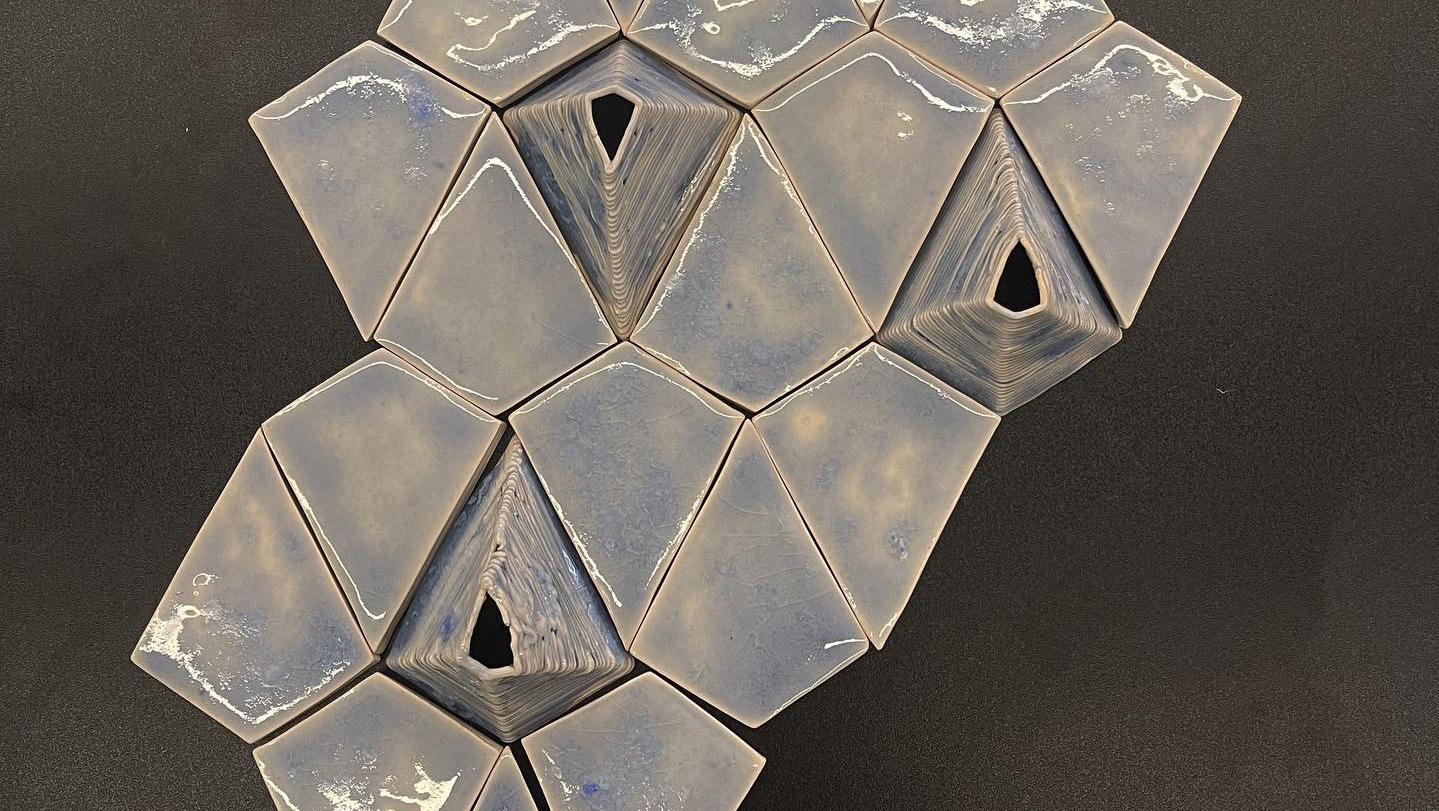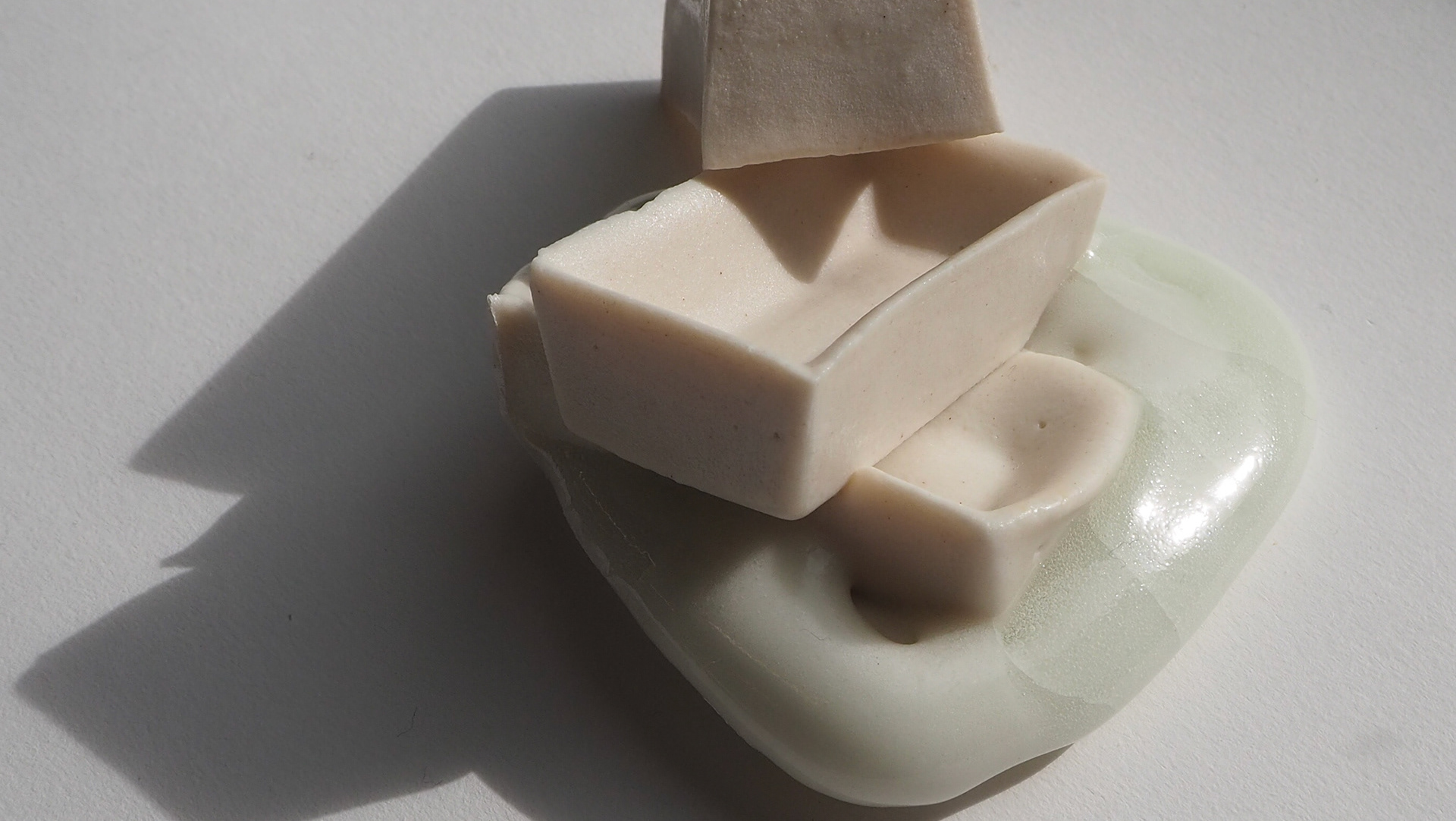Project background and context.
My project delves into the complex impact of the British National (Overseas) visa on Hong Kong immigrants moving to the UK since its 2021 introduction. I have been drawing from urban observations in Manchester and Hong Kong to explore notions of belonging deeply. Metaphorically connecting glaze's fluidity to immigrants' unsettled history, I employ 'reverse thinking' and 'deconstruction' theories in my ceramic works. Through the definition of deconstruction, I seek to find a renewed sense of belonging during the transition from one city to another.
My experimentations with glaze challenge conventions about the role of glaze in ceramics. On the other hand, using AI- Midjourney- has become part of my creative process. I discovered the language of nonsense from AI while I generated Manchester and Hong Kong's street views. The creation of "AI language" that mimics but isn't identical to real languages leads to intriguing results and challenges assumptions, its potential to inspire new perspectives and creative exploration has led me to generate pictures of actual buildings in the city to a destructive state. Explore the theme between reality and virtual, I aim to create a surreal experience for the audience when looking at my work, and reimagine our identities, just like the unreal generated AI images.
My exploration then extends to bricks, taking inspiration from the architectural landscape of the UK, particularly its brick buildings. Bricks symbolize both stability and fragility, reflecting on themes of stability and fragility inherent in the immigrant experience. I metaphorically link this transition to the fluxing between clay and glaze, which explores the interplay between clay and glaze, I seek to capture the essence of transition and transformation, mirroring the journey of Hong Kong immigrants relocating from Hong Kong and adapting to life in the UK. A process that reflects the flux of identity and belonging. Through exploring the unusual possibilities of ceramic, my process involves glaze-casting, I utilize glaze-casting techniques and the heat in the kiln to construct and deconstruct my ceramic tower, to explore themes of transition and belonging further. Through my artistic process, I aim to unearth a renewed sense of belonging, inviting viewers to contemplate their own experiences of transition and identity within my creations.
In conclusion, my artistic journey is a continuous exploration of identity, belonging, and transformation. Through my work, I aim to provoke thought, evoke emotion, and inspire contemplation. As we navigate the complexities of migration and adaptation, may my creations catalyze dialogue and reflection, to find a renewed sense of belonging in an ever-changing world.
BRICKS ARE EVERYWHERE, AROUND ME.
While on my research of city observations, seeing the difference between Hong Kong's architecture and UK's, I realised the most significant building material in the UK is clay red bricks. When I see bricks, bricks are everywhere in the UK, and Manchester is no exception. Even though it seems like red brick is significant in UK architecture, brick has been identified as a universal common building material. That's when I started to think of using bricks as a form in my project, as a universal language and symbol of architecture.
Seeing bricks daily has seemingly influenced my creation. Bricks represent stable, safe, and not likely to move or change. Therefore, I wonder if I make a piece of brick detort, that might challenge people's conventional assumptions.
Soft Bricks
Brick represents stability as a universal symbol. Brick constructions are sturdy. At the same time, a brick building can be disassembled and collapsed into a pile of broken bricks by man and machine, or even nature. I want to bring up the opposition to its meaning, softening the bricks and letting it collapse as if it shouldn’t be. My theory behind brick has led me to start doing the material experiment, explore the fluxing between clay and glaze, and discover how a single material changes from one state to another. My process has involved casting glaze and clay in plaster mould, constructing the casting pieces into construction and deconstructing it while firing in the kiln. Last semester I explored glaze as a stand-by-alone material, while adding more clay to the glaze to stiffen it, I realised glaze is clay, and vice versa. Since then, I have been exploring one type of clay, adding fluxes in different percentages, and exploring the changes between clay and glaze.
Demolition site
I have walked around Salford where I live, and discovered a demolition site at 50 N George Street. There are a massive pile of bricks on site. I believe there was a house/ building before, but I couldn't find any information about this site. It has been left unidentified.
Crosby Beach
Countless rubbles, like bricks, mortar, and tiles can be found all over Liverpool's Crosby Beach. They are left behind after World War II Blitz. Years after years, the tide erodes the bricks, softening their edges. Many of them look like pebbles, very round and smooth, from this I can imagine how long these bricks have been on this beach. The houses and buildings have been destroyed and the bricks are left after conflicts, they could have been some people's homes in the past. This has brought me emotions about them.
DARWEN TERRACOTTA
I have looked back on the visit to Darwen Terracotta last year. They have worked on both restoration and new build projects for some of the most prestigious buildings in the UK and worldwide. The repetitive moulds fascinate me. They have made many plaster moulds to make repetitive tiles in different designs. They also have a glazing section that stores their glaze samples and material samples for making their tiles for buildings.
The visit has a significant impact on me. Looking at how they use the moulds to make repetitive objects to build the buildings has influenced me to think about how to make my glaze pieces and build them into construction.
Collapsing buildings as the form of my pieces.
The scene of collapsing buildings, either in the demolition process by man and machines, or the ones destroyed by nature, fascinates me. This has led me to apply the 'deconstruction' concept in my project. The blocks of the building fall dramatically, and I can feel the gravity in the photos. I try to replicate the visual effect and the state of deconstruction in the form of my pieces.
Brick shapes plaster moulds.
Nowadays most bricks in the UK are made to a standard size of 65 X 102.5 X 215 MM, which gives a ratio of 3:2:1. I referred to the ratio of the brick's size and came up to the size to make my glaze pieces: 16.25 X 25.625 X 53.75 MM.


